Contents
Nevezhinskaya mountain ash belongs to the sweet-fruited garden forms. Known for about 100 years and is a variety of ordinary mountain ash. It was first found in a wild form near the village of Nevezhino, Vladimir Region. Since then, a tree with dessert-flavored berries has been grown in household plots. Mountain ash is planted as an ornamental tree with fruits of high vitamin value.
Description of mountain ash nevezhinsky
Rowan Nevezhinskaya is a deciduous tree that belongs to the Rosaceae family. Differs in tallness, when growing in illuminated areas, it forms a spherical crown, in the shade – a triangular one. But prefers sunny areas.
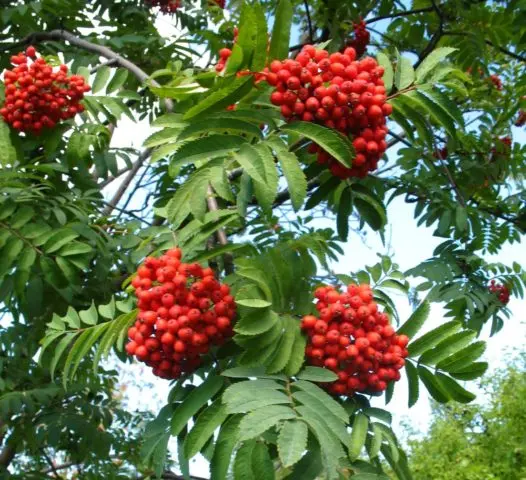
The bark is gray-brown, the root system is superficial. The leaves are large, dark green, lanceolate. Flowering is plentiful, begins in May-June. The flowers are white, collected in dense inflorescences. Flowering is accompanied by a sharp aroma for humans, but attractive to bees, aroma. Therefore, Nevezhinskaya is a good honey plant.
Nevezhinskaya fruits are from light orange to bright red. The berries are larger in size than those of ordinary mountain ash. They have a dessert taste without astringency and are high in vitamins. The berries ripen in early autumn and remain on the tree until the cold weather. Seeds are small, light brown.
It has been noticed that cultures of the nightshade family planted next to mountain ash are not subject to late blight. But with fruit trees, mountain ash is recommended to be planted separately.
The Nevezhinsky variety is winter-hardy, unpretentious to growing conditions. The flowers withstand temperatures as low as -2,5°C. The tree is acclimatized for cultivation in Siberia. It enters fruiting in the 5th year of cultivation.
It shows high yields, including in rainy and cold summers, when other garden trees do not have good fruiting. Rowan nevezhinskaya is a long-lived tree and has been growing in one place for about 30 years.
Varieties of rowan nevezhinsky
Rowan nevezhinskaya has 3 varieties that are similar in crown shape, but differ from each other in color and taste of berries. Rowan Nezhinskaya or Nevezhinskaya is one and the same culture. The name “Nezhinskaya” was given by one winemaker back in the last century to hide the real name of the tree and not to share sweet berries with others who want to get them.
Nevezhinskaya cube
Kubovaya is the more common variety of all three belonging to Nevezhinskaya. The berries are orange with red color, pentagonal shape.
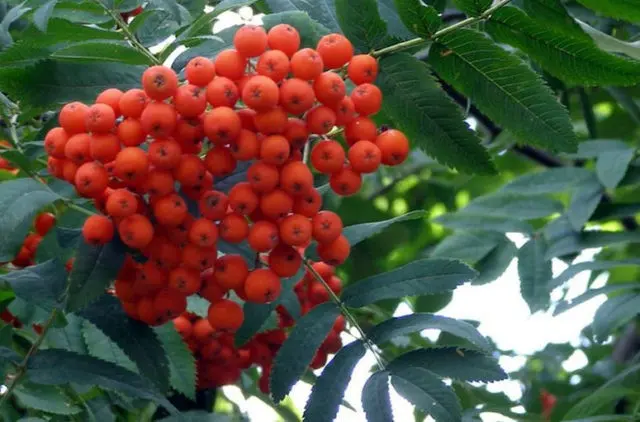
The taste is sweet and sour, without astringency, the weight of one berry is 0,5 g. The variety is productive. With shaping, it can be grown in the form of a bush. From the cubic variety, crossed with the varieties Businka and Juicy, the varieties Daughter of Kubovoy and Solnechnaya were formed.
Nevezhinskaya yellow
According to the name, the berries of this variety are distinguished by an orange-yellow color. In the photo of the Nevezhinsky yellow mountain ash, you can see that the tree is large-sized, but its branches are more tonic than those of the cube. Also, the branches are plastic – they bend, but do not break under the weight of a large number of fruits.
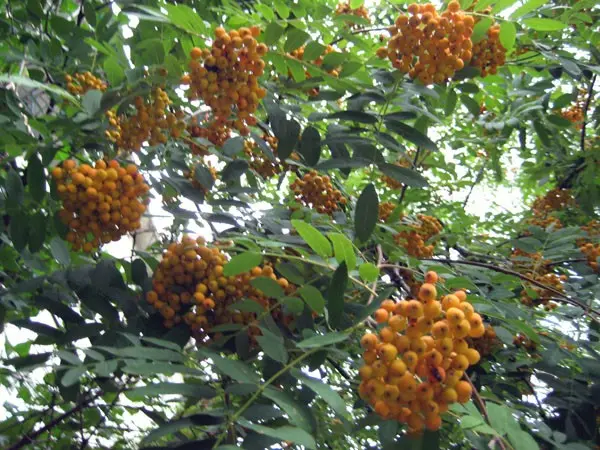
The berries are rounded, ribbing is noticeable. The fruits of the yellow variety are used to make kvass, jams, tinctures. Harvested by the method of drying and urinating.
Nevezhinskaya red
The variety differs from the other two types of Nevezhinsky larger berry of bright red color. In terms of sweetness, the red berry also surpasses the cubic and yellow ones.
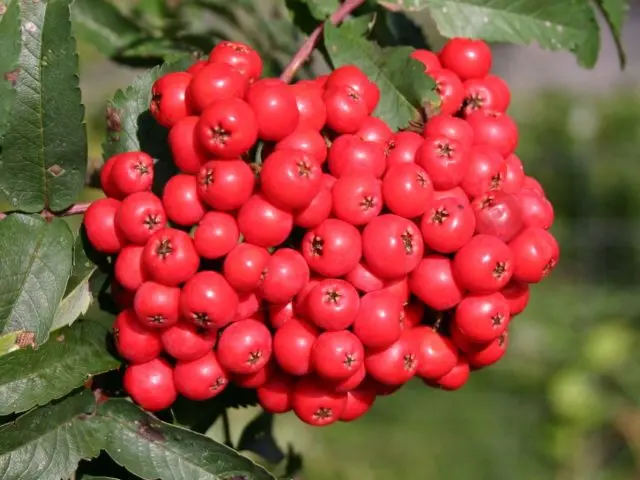
The pulp of the Nevezhinsky red rowan fruit is juicy, with a sugar content of 10-12%. The tree may differ in the frequency of fruiting. The yield increases with the age of the plant.
The benefits and harms of rowan nevezhinsky
The fruits of Nevezhinskaya are used for beriberi and reduced immunity, the restoration of the body in the postoperative period. In terms of vitamin C content, berries are superior to lemon and currant. According to the general multivitamin composition, they are similar to sea buckthorn.
Nevezhinskaya contains high amounts of iron, pectin and sorbitol. It is a dietary berry. Normalizes blood sugar levels, improves sleep and mood.
With all the positive properties, rowan berries should not be consumed by people with low blood pressure, prone to allergic reactions, women during pregnancy and lactation. Berries tend to increase blood clotting, so they are not recommended for people with a predisposition to thrombosis.
The use of rowan nevezhinsky
Rowan nevezhinskaya is used as an ornamental and food tree. Berries are used to make tinctures, jams, marshmallows, marmalades and compotes. The leaves are used to make fermented teas. The fruits are consumed fresh and dried. The berries are also suitable for feeding farm animals and birds.
Durable furniture is made from wood. Leaves shift vegetables stored in cellars and piles.
Planting and caring for rowan nevezhinsky
In order to get a garden view of the sweet nevezhinsky mountain ash, you need to purchase a cutting seedling or grafted onto the rootstock of an ordinary mountain ash. This deciduous, ornamental tree is unpretentious in cultivation and care. Mountain ash, including varietal, can grow safely on different types of soil, but light and medium loams are preferred for planting.
Site preparation
Nevezhinskaya is planted in bright, high areas. The tree is not afraid of drafts, so it can be used to protect more heat-loving crops from the winds. When planting in groups, a distance of about 2 m is observed between trees.
Young trees with a bare root system are planted in the spring after the melt waters melt or in the first period of autumn before the onset of frost. When planting in spring, it should be borne in mind that the culture starts growing early.
Rules of landing
For planting 1-2-year-old Nevezhinsky mountain ash, they dig a planting hole 60 cm in size on all sides and depth. When planting older seedlings, the pit is increased according to the size of the root system. A layer of drainage is poured at the bottom of the landing pit – 20 cm. Broken bricks of a large fraction or stones are used for drainage.
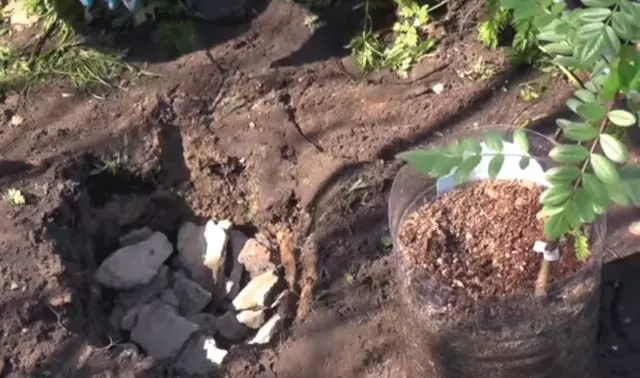
Fertile soil is poured over the drainage. To increase fertility, rotted manure or compost is added to ordinary garden soil. On very poor soils, a handful of any complex fertilizer is added to the planting hole. Mineral fertilizers are poured between the soil layers so that the roots of the seedling do not come into direct contact with them. The seedling is carefully removed from the container and lowered vertically into the planting hole.
The soil at the planting site is tamped to ensure good contact of the roots with the ground.
Broken or dried shoots are cut off. The planting is watered. At first, the seedling is covered from the bright sun. An ornamental tree takes root for several years and shows little growth in the first years. The culture begins to bloom and bear fruit after 3-4 years, depending on the age of the planted tree.
Watering and top dressing
The tree is watered additionally up to several times per season, especially with a lack of precipitation and drying of the soil. With prolonged drought, a young plant may die, and an adult drastically reduces the number of fruits.
Top dressing is carried out once every few years. To do this, a shallow furrow is dug along the diameter of the near-stem circle. Manure, compost or mineral fertilizers are added to it and covered with a small amount of garden soil.
Pruning Nevezhinsky mountain ash
Rowan nevezhinskaya without forming branches grows into a very tall and large tree. To have access to the berries that are located on the tops of the branches, the growth of the tree is restrained by pruning. The plant, when adjusted in height, forms more side branches and grows well in width. For shaping in the spring, before the start of sap flow, the branches are cut 10 cm below the topmost bud.
In order to form a culture in the form of a bush, an annual seedling is cut above the third developed bud and led into 3 trunks.
Preparation for winter
Rowan is frost-resistant and does not require special shelter for the winter. In order to prevent the light reflected from the snow from overheating the bark in the last winter months, the trunk is covered with screens or wrapped in burlap.
Pollination
Rowan nevezhinskaya planted singly does not bear fruit, because it is a self-fertile tree. In order for the berries to start, it is necessary to plant several other types of this crop in the neighborhood.
Harvesting
Nevezhinskaya berries can be harvested as they ripen. In various regions, berries ripen in late summer – early autumn.
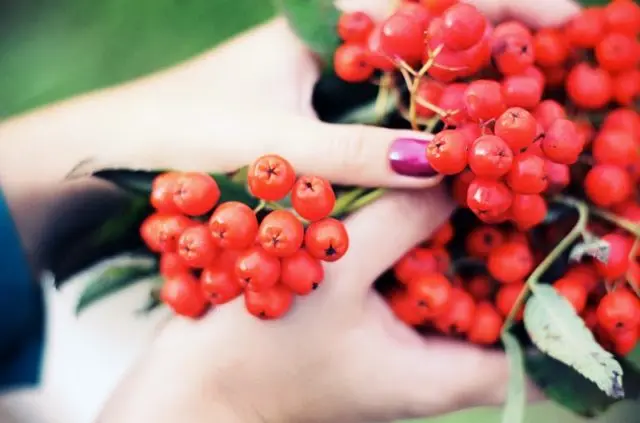
Unlike ordinary, Nevezhinsky mountain ash does not need to be frozen or wait for cold weather to collect it. Berries have a pleasant taste even when unripe.
Diseases and pests
Rowan is less susceptible to diseases and pests than other fruit trees in the garden. Most often, infections occur during rainy summers. The most common disease is rust, especially when grown near coniferous trees and shrubs. Fungal diseases can affect leaves and fruits. Bordeaux liquid is used for treatments.
Pests that affect rowan nevezhinskaya:
- rowan aphid;
- rose aphid;
- hawthorn;
- ringed silkworm;
- mountain ash leaflet;
- rowan moth;
- sawfly.
To combat and prevent the occurrence of pests, mountain ash, like other garden trees, is treated with insecticides. In autumn, fallen leaves and fruits from under the tree must be raked and burned because of the risk of wintering pests in them. For the same purpose, they make a shallow digging of the soil around the trunk circle.
Ultrasonic repellers are used to control birds.
Reproduction
For propagation of Nevezhinsky mountain ash, the seed method is not used, in which the sweet taste of its berries is not transmitted. Only the vegetative method is suitable for propagation, for example, by grafting or budding. Rowan rootstock grafted by budding shows good survival and intergrowth with the rootstock. As a stock for Nevezhinskaya, an ordinary or chokeberry can serve. Nevezhinskaya grafted onto chokeberry does not grow as tall as grafted onto ordinary.
On a varietal mountain ash, in turn, you can graft chokeberry, shadberry or pear. But this will reduce the longevity of the culture.
Conclusion
Nevezhinskaya mountain ash is an ornamental fruit tree that is used for landscaping areas. Berries are used to fortify the body, especially in winter. Nevezhinskaya in appearance differs little from an ordinary wild-growing mountain ash, but its berries do not contain bitterness. Nevezhinskaya is zoned throughout Our Country and is unpretentious in care.









